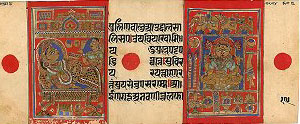
Kalpasutra in Ardhamagadhi Prakrit on paper, Vikramasamvat, 1509
The Kalpa Sutra consists of religious Jain texts, dealing primarily with the lives of the Tirthankaras; it ends with the birth and life of the historical Mahavira.
It was translated by Hermann Jacobi 1854.
For Shvetambara Jain is concerned the Kalpa Sutra is his most important sacred text. It is revered almost in the same manner by him as the Bhagavadgita is revered by an ordinary Hindu. The Kalpa Sutra in the present form is also the first text of the Shvetambara Church, not accepted by the Digmabaras. The writer of Kalpa Sutra is Bhadrabahu. But the whole of the Kalpa Sutra cannot be ascribed to Bhadrabahu who, had died 170 years after Mahavira. The Kalpa Sutra has three sections. The first section contains the Jinacaritra, "the biographies of the Jinas." The main portion in this section is the biography of Mahavira. The second section of the Kalpa Sutra consists of the Ther avali, i.e. the list of the pontiffs, and also the name of the schools (gana), their branches (sakha) and names of the heads of the school. This list contains names of the heads of the school. This list contains names of the pontiffs up to Devarddhi nearly 30 generations after Bhadrabayhu. Thus this list could not have been compiled by Bhadrabahu himself.
The third section of the Kalpa Sutra contains the Samacari, or Rules for the ascetics, namely, the rules for the rainy season (Pajjusan). It has been conjectured that this, the oldest section of the Kalpa Sutra was the work of Bhadrabahu. Indeed the complete title of the Kalpa Sutra is Pajjosanakappa, though this name fits only the third section. The other two sections according to the tradition, were added later by Devarddhi.